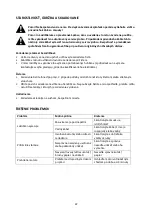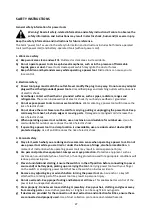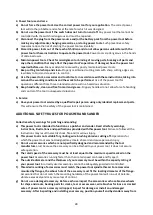
O
PERATION
Personal protective equipment
•
Wear protective gloves.
•
Wear protective goggles
.
•
Wear hearing protection for protection from continuous noise in the work place.
•
Wear dust mask for protection from airborne dust.
Check whether the type of the plug corresponds with the type of the socket
.
The data on the nameplate must correspond with the actual power supply voltage.
Switching on
Push the safety lock
-
out button (
5
) and keep it pressed.
Press the on
-
off switch (
6
) to turn on the polisher. Once the
p
olisher
is running you can release the safety
lock
-
out.
Switching off
Release the switch
(6)
.
Setting the rotation speed
Rotation speed can be set using the setting wheel (
4
). The required speed depends on the material and
the working conditions and should be tested on a sample of material.
Working with the polisher
•
The machine is equipped with a soft
-
start feature.
W
ait until the machine reaches the set
rotation
speed. Then you can place it on the workpiece and begin working
.
•
Do not attempt to increase the working speed by putting more pressure on it. The polishing and
sanding tools work more efficiently when only light pressure is applied.
•
If the machine heats
up intensely, allow it to run idle for 3 minutes so that the motor can cool down
.
Polishing
•
Select low speed for polishing in order to avoid excessive heating of the surface.
•
Apply polish
or wax
evenly on the
clean and dry surface.
Follow the instructions given by the
polish
/
wax manufacturer.
•
Work with the polisher
in crosswise or circular motion with light or moderate pressure.
•
Do not allow the polish to dry out.
There is a risk or surface damage.
Therefore, do not work in direct
sunlight
or on a heated surface.
•
Clean the polishing accessories regularly to ensure
good polishing results. Wash
accessories with
a
mild detergent and warm water;
do not use thinners or chemicals
.
•
Replace the polishing accessory when worn out too much.
Sanding
•
Pay attention to apply uniform sanding pressure; this increases
the working life of the sanding
sheets.
Do not exert too much pressure on the tool.
•
Regularly check the condition of the sanding sheet. Replace when necessary.
•
On very uneven surfaces, start with a coarse grit and gradually change to a fine grit for smooth finish.
•
Always use
a suitable sanding paper for the material being worked on (wood, steel, paint etc.).
32
Summary of Contents for PATRIOT LE1100
Page 2: ...2...




































